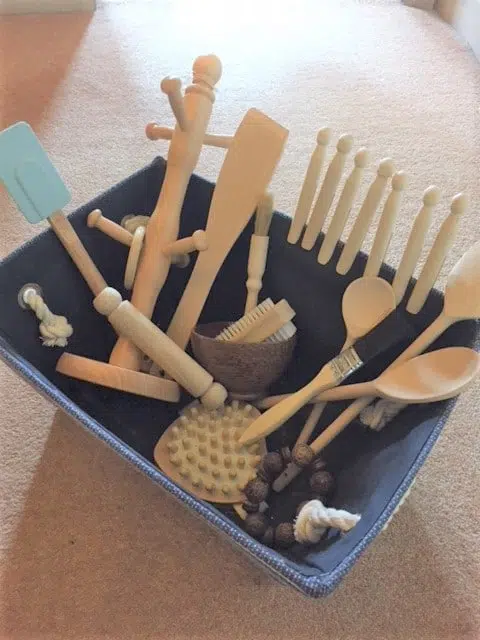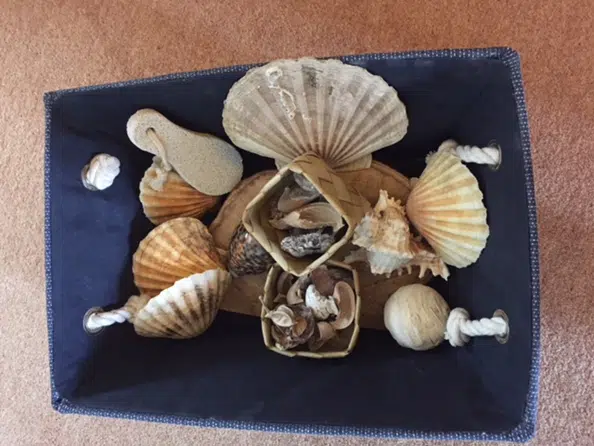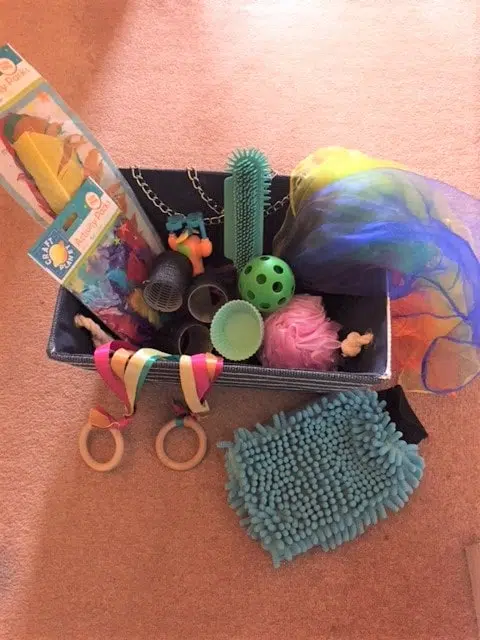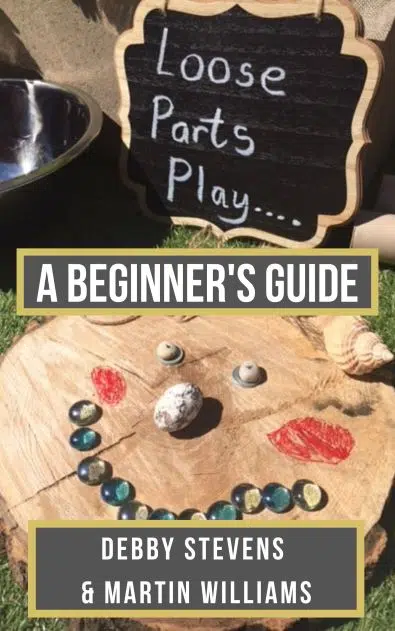The term ‘heuristic play’ is often used in childcare circles, but rarely as part of normal speech by people or parents outside the industry. However, it is a type of play that probably all parents have witnessed. To simplify the term, it is playing with everyday objects, and moving around with them in different ways.
But have you ever wondered what are the benefits of this type of play?
There are many benefits of heuristic play, including developing a child’s independence, deepening their concentration, expanding their problem solving and thinking skills, and developing their gross motor abilities.
This, however, is just the tip of the ice-berg.
In this article I will quickly look at what heuristic play is, what it might look like, and then get stuck into the most important 18 benefits of this fantastic style of play.

What Is Heuristic Play?
Heuristic play is something that will often occur naturally when children reach a certain age, and are surrounded by an environment that makes it possible.
It is a term that was originally introduced by the psychologist Elinor Goldshmeid.
The central feature of heuristic play is a child’s natural curiosity in objects.
When babies interact with objects using things like treasure baskets, they are happy just to feel them. Later on they develop a sense of experimenting, of wanting to know what they can do with them. This is heuristic play.
If you want to find out more about treasure basket play then you can check out this article about what they are and how to use them.
When Does Heuristic Play Take Place?
Heuristic play normally happens between the age of 1 and 2. A child needs to be able to move around a bit to begin this form of learning. They also require that curiosity to have been built up, and that they have reached a state where they will be enquiring about how to use everyday objects in different ways.
What It Looks Like
In concrete terms, children around the age of 1 like to do lots of the following things with objects:
- Fill them
- Manipulate
- Dump them!
- Stack
- Handle
- Gather
- Select
- Transport
- Roll
- Post
- Cover
The big difference between this type of play, and what the children have tried before, is movement. The children will be moving, and so will the objects!
If you want to find out what kind of objects to use in this kind of play, then I have written an article about the best materials to use in loose parts play with at least 100 examples!

What Do You Need To Make Heuristic Play Happen?
You basically need a space free of too many distractions, where the children have access to a large number of everyday objects, and the space and freedom to let them interact with them.
Children will:
- Try things out
- Repeat ideas
- Experiment
- Demonstrate their curiosity
Heuristic play is relatively simple to achieve either at home or in an educational setting, and this article is just as much for parents as it is for educators.
In heuristic play children are like scientists exploring and investigating reality. If you want to learn more about the best science loose parts play ideas then check this article out.
Right, now you know the main features of heuristic play, let’s find out the many benefits…
The Benefits
1.Independence
Independence is a huge deal in life, and it is one of the most important values that the early years teaches.
In heuristic play the focus is all on the child. It is up to them to decide what to do and who to do it. They are in control of their decisions, their actions, and on the physical world around them.
Children will use trial and error, testing their own theories.
They will create hypotheses and investigate and test them.
Independence is one of the most important parts of loose parts play in general. If you want to find out more about this, then check out my article about the 14 most important benefits of loose parts play with examples.
2.Concentration
Their has been research demonstrating a link between heuristic play and brain development.
Anyone that watches children engaged in good quality heuristic play will know too well that this almost seems obvious. The high levels of engagement and thinking must be stimulating positive development.
Children will often be involved in this form of play for an extended period, much longer than they will engage in most other activities.
This type of prolonged engagement develops their concentration, and their ability to continue with one train of thought.
3.Total involvement
Linked to concentration, is this state of total involvement that many children will go into.
This state is called many things in our culture – getting ‘into the zone’, or experiencing a ‘state of flow’ are two ways it is often referred to.
This is a high form of mental functioning, when humans and fully focussed and can make great achievements and progress.
Though of course this will not happen every time a child engages in heuristic play, you will often see them really getting into it, and these times are like magic!
4.Creativity
This is one of the number one benefits of heuristic play. The amount of creativity on display can be amazing.
A simple object like a colander can be used in so many ways. You can put things in it, turn it upside down, wrap it up, roll it, spin it, put it on your head or other parts of your body.
Children learn to think ‘outside of the box’ to an extent. Objects are not seen for their normal function, but as tools for their imagination to try out all sorts of wonderful tips and tricks.
5.Movement
Heuristic play is all about movement. Children will be moving forward and back, twisting, turning, bending, and generally allowing their curiosity to motivate their movements.
Children will often be moving all over the space when they engage in this kind of play. They will go through periods of quicker movement, and of being more still.
Through this movement, they learn how to use their bodies, and strengthen their coordination and agility.
6.Gross Motor
Children will be continually moving their arms and legs, and using their torsos to bend and twist.
This form of play is great for learning how to:
- Pick up objects
- Transport and carry
- Wrap things up
- Post things
- Stack and roll things
Outdoor play is also fantastic for this kind of gross motor development, and you can find out more about outdoor loose parts play here.
My free ebook also contains a large amount of outdoor loose parts. You can download ’50 Outdoor Number Activities On A Budget’ here.
7. Beginnings Of Fine Motor
Although heuristic play is more concerned with larger gross motor movements, it will be sowing the seeds of fine motor development as well.
Some examples include:
Pulling scarves with their fingers
Posting objects into holes
Picking up and exploring objects with thin handles or sections, such as a whisk, or a wooden spoon
Remember not to include anything too small in heuristic play, however, as this can provide a choking hazard. Find out how to risk assess loose parts play here.

8.Critical Thinking
This is another huge benefit of heuristic play, and can be seen being acted out in several different ways.
Critical thinking in children is basically children creating tactics, choices, ideas and strategies. To break this down a little…
Children will invent their own ideas. For example, a boy might try rolling an egg-cup around the room.
They will make links between ideas. As an example of this, a child may find out that a whisk makes a great sound when hitting a pot. Will a wooden spoon make the same kind of sound?
Children will develop strategies. They start to understand, for example, that if a large brush won’t fit inside a small box, it will fit into a big box.
Children are faced with problems and situations, and they overcome them by thinking critically.
9. It’s Multi-Sensory
Heuristic play will be stimulating all of the senses.
For example, it is a good idea to use objects that make a range of noises, such as shells in a glass jar. This aids early phonics skills and listening. Some other good early phonics articles you might like are:
-10 Terrific Alliteration Actitivities For Early Phonics
You can stimulate smell by using objects like lemons or limes, or leather objects.
Children will be interacting with the objects using most of their senses. This means that different learning styles will be taken advantage of. Children who are very kinaesthetic will benefit, just as much as those that are more visual or auditory.
Also the range of senses involves strengthens the level of engagement and curiosity that children find when interacting in this style of play.
10.Understanding Of The World
Children are like scientists when engaging in heuristic play.
They are setting up experiments and finding out the results.
They are exploring their environment.
They are developing an understanding of the properties of objects, and also a deepening understanding of themselves.
11. Imagination
Heuristic play is led by imagination.
They are thinking about how the experience can be brought to life. What can they do with these objects, and what will happen?
The big emphasis is on the child. Without imagination, nothing will happen.
Often children will come up with one idea, and then repeat it many times on different objects. This is schema play, and involves trial and error.
They generate ideas, and test them out over and over, all the time the ideas being instigated by imagination.
We cover schema play and how to optimize it in great detail in our online course ‘Project Loose Parts.’ This is the ultimate step-by-step guide on how to set up an outstanding environment where loose parts play can flourish. We have members in our community from around the world. You can check out our Project Loose Parts online course here.
12. Mathematical Concepts
There are many maths concepts that will explored in this style of play, and children will be developing pictures in their minds and concrete experiences of things that they will learn about in more depth in the future.
Some examples of mathematical learning include:
- Exploring how differently shaped objects can roll or not roll
- How some things can be stacked and some can’t
- Some items can fit into others and some are too big
- Some things are heavier or lighter than others
- Some objects are harder to wrap up because they might be bigger
To check out my article about 50 fantastic outdoor maths ideas then go here.
13. Understand Limits Of Own Physical Self
There will be some things that you find you can do during this type of play, and some that you can’t.
For example, you learn how to transport differently sized and shaped objects safely.
They will learn how to they can post, or stack or wrap things up.
14. Construct And De-Construct Reality
Children are continually coming up with theories. Then something happens, and that theory is shattered, and so they come up with another one.
For example, a child might try to stand up a wooden spoon on its end. When it falls over a few times, they may forget that and try standing something else up instead. They are learning about which objects can stand up and which can’t.
They are shifting their view of reality.
Often it seems ridiculous what they are trying to do! But then they try, fail, and learn from what they have seen.
Heuristic play generates a perpetual stream of these types of experiments.

15.Freedom
Children have independence to choose what they do and how to do it.
They become decision makers, and masters of their own destiny.
Giving children the freedom to learn, make mistakes, and experiment is paramount in helping them form a healthy view of the world, and of their own abilities.
16. Economy
This a particularly important benefit for parents and many educational institutions (if not so much one for the children!)
Heuristic play is cheap!
All you need are some random objects that you will probably be able to find around your house, or from friends and family.
Heuristic play does take time, strategy and adult guidance, but it is definitely at worst very cheap, or alternatively potentially free!
17. Open Ended
One of the beauties of heuristic play is that there is no fixed outcome. There is no concrete objective, or set structure.
A wooden spoon, for example, will rarely be used for its standard purpose. It will be posted, used to hit things, balanced on top of things, put into objects, and all other sorts interesting uses will be dreamed up.
Children are able to explore in a world of wonder and ‘what if?’
18. Laying The Foundations For Loose Parts Play
Heuristic play is the natural stage of play for children of this age. This will develop into more complex loose parts play when a child is roughly around the age of two.
A good level of exposure to this type of learning at this age will mean the child will have greater confidence to access open-ended or loose parts play later on. I have written an article about my favorite 40 loose part play activties that you can find here.
Top Tips For Delivering Heuristic Play
Here are some basic top tips to get you started with heuristic play:
- The adult doesn’t really need to interfere. If the children are interacting with objects then just leave them to it. Only intervene to stop anything dangerous
- Have an environment free from distractions, e.g. turn of the TV, and clear the space of other toys
- Regularly change the objects that you use for heuristic play to keep the experience fresh and engaging
- Think about safety, and don’t include any objects that could be either a choking hazard, or something they could wrap around their neck
Conclusion
Heuristic play is a simple but fantastic form of play that is easily achieved either at home or in an educational setting.
There are a huge number of benefits, many of which you probably might never have thought of. Children develop mentally, physically and emotionally through it, and learn rapidly about the physical world.
What Next?
If you are reading this and live in the UK, you might want to check out our Loose Parts Play practical training course that we run at venues throughout England and Wales. This is open to both parents and educators. Here is a link to a description of that course.
This article is an expanded extracted from the book ‘Loose Parts Play – A Beginner’s Guide’ written by myself and my colleague Debby Stevens. This book provides a full, yet simple guide to setting up an outstanding loose parts culture in your home or educational setting with children aged 0-5. To check out the book on Amazon, then follow this link

